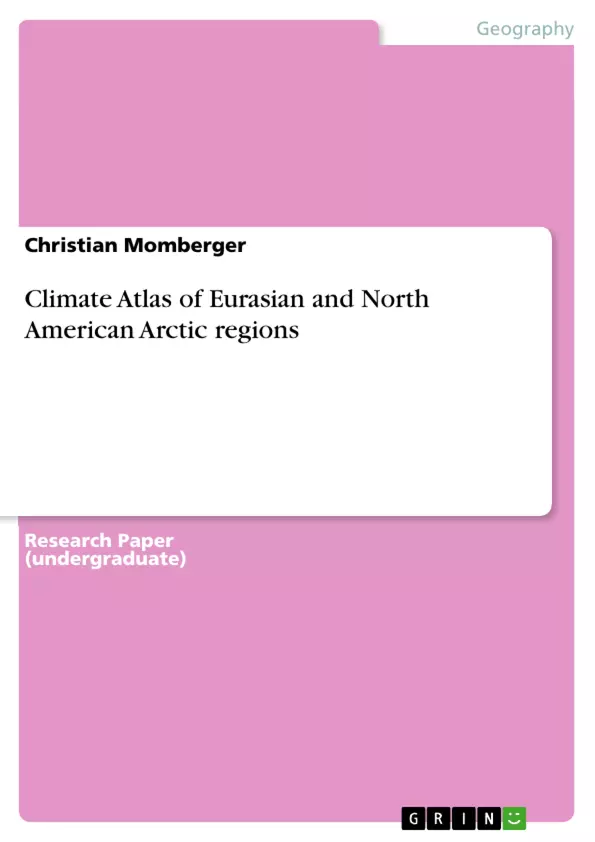The present climate atlas will show the climatic differences between selected arctic regions from Eurasia, or strictly speaking Russia, and North America. The main emphasis will thereby be put on the difference between oceanic (maritime) and continental climate. It will also show the spread of permafrost and the localisation of the Arctic tree line, which both depends on the existing climate.
In the Appendix, the climate-diagrams for each selected station and equivalent maps of the chosen sections and for the locating of the tree line and the permafrost can be found.
------------------------------------------------------------------
Der hier vorliegende Klima-Atlas zeigt die klimatischen Unterschiede zwischen ausgewählten Arktischen Region in Eurasien (Russland) und Nordamerika. Der Schwerpunkt wird dabei auf die Unterschiede zwischen maritimen und kontinentalen Klima gelegt. Im Klima-Atlas wird aber auch auf die Verbreitung der Permafrostgebiete und den Verlauf der arktischen Baumgrenze eingegangen.
Im Anhang finden man die Klimadiagramme für jede ausgewählte Klimastation und entsprechende Karten für die gewählten Sektionen sowie zur Verbreitung des Permafrosts und dem Verlauf der arktischen Baumgrenze.
Table of Contents
- Introduction
- Arctic climate stations
- Siberian Section
- Komi-Nanette Section
- Quebec Section
- Central-Canada Section
- Alaska
- Permafrost and Arctic tree line
- Conclusions
- References
- Appendix
Objectives and Key Themes
This climate atlas aims to showcase the differences in climate between selected arctic regions in Eurasia and North America, emphasizing the contrast between oceanic and continental climates. It also explores the distribution of permafrost and the location of the Arctic tree line, both of which are influenced by climate.
- Comparison of oceanic and continental climates in the Arctic.
- Influence of climate on the distribution of permafrost.
- Location and characteristics of the Arctic tree line.
- Analysis of climatic data from various arctic regions.
- Presentation of climate-diagrams and maps for selected stations and sections.
Chapter Summaries
The introduction provides a brief overview of the differences between oceanic and continental climates and how they influence the Arctic environment. It also introduces the concept of the Arctic tree line and permafrost.
Chapter 2 presents a detailed analysis of climate variations within the Arctic, focusing on four south-north cross-sections – two from Eurasia (Russia) and two from North America (Canada). The section also includes an analysis of the climate station Fort Yukon (Alaska), which exhibits a highly continental climate. Each station is characterized by its geographical location, altitude, mean monthly and annual temperatures, monthly and total precipitation, temperature range, extreme minimum temperature, vegetation zone, and type of permafrost.
Chapter 3 provides a brief discussion of the Arctic tree line and permafrost, highlighting their relationship to climate and other environmental factors. It also defines four types of permafrost based on their extent: sporadic, isolated, discontinuous, and continuous.
Keywords
Key terms and concepts explored in the text include: arctic climate, oceanic climate, continental climate, permafrost, Arctic tree line, temperature amplitude, precipitation, vegetation zones, Taiga, Tundra, climate stations, Siberia, North America, climate diagrams, maps.
- Quote paper
- Dipl. Geogr. Christian Momberger (Author), 2001, Climate Atlas of Eurasian and North American Arctic regions, Munich, GRIN Verlag, https://www.grin.com/document/113747



